Homepage | Biogas | Biogas installations | Economy of biogas installations | Biogas incomes | | Projects Gallery | Contact
PAK Renewable Energy
PRE - Informations
Introduction of Bio Gas

Biogas can provide a clean, easily controlled source of renewable energy from organic waste materials likes Cow's Dung (Goober) & etc.. for a small labour input, replacing firewoood or fossil fuels (which are becoming more expensive as supply falls behind demand). During the conversion process pathogen levels are reduced and plant nutrients made more readily available, so better crops can be grown while existing resources are conserved.
Since small scale units can be relatively simple to build and operate biogas should be used directly if possible (for cooking, heating, lighting and absorption refrigeration), since both electricity generation and compression of gas (for storage or use in vehicles) use large amounts of energy for a small output of useful energy. This concept is suited to "distributed" systems where waste is treated near the source, and sludge is also reused locally, to minimise transport and initial capital cost compared to a "centralised" system. As the distributed system will need a support network biogas contributes to the "triple bottom line"; benefiting the environment, reducing costs and contributing to the social structure.
Introduction of Anaerobic Digestion (PPSX) (Require Microsoft Power Point)
Biogas composition

Biogas is a fuel gas, a
mixture consisting of 65% methane (CH4) and of
35% CO2. It is a renewable energy resulting from biomass.
Biogas composition
Resources of biogas in the world

According to a study made
by the ADEME
biogas represents in the world a resource comparable to fossil
gas
yearly consumption (1.800 Mtep/year). This energy is too dispersed in
the world to be easily recoverable but the potential is evaluated from
100 to 300 Mtep/year. The quantity valued today is that of 0,5% of the
total potential.
Biogas resources in the
world
Fermentation (or anaerobic digestion)
Fermentation (or anaerobic
digestion)
is the process of degradation of the organic substances using the
micro-organisms also known as anaerobe.
Anaerobic
digestion
Energetic valorisation of biogas
In the case of a valorisation by a co-generation engine, the
heat
can be used locally which improves the energy output of valorisation.
Moreover, electricity resulting from biogas can be sold to electricity
distributors.
Biogas
valorisation
Economy of biogas
The receipts are
calculated based on
the assumption that the producer of biogas is also the consumer. In
this case, they will have to support the overall investments but will
recover the totality of the benefit, and have savings compared to
fossile fuels.
Biogas economy






